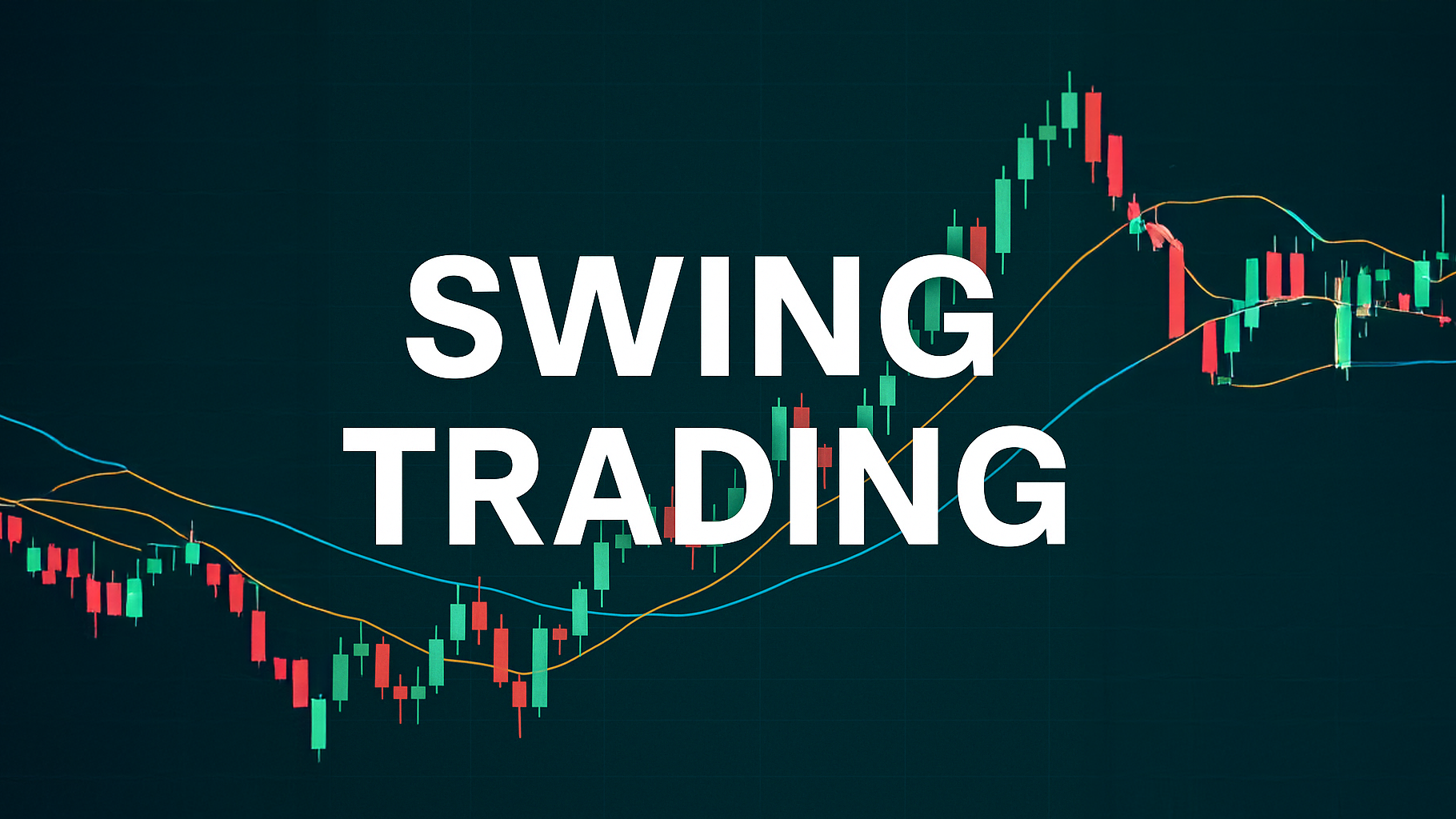Learn the essentials of swing trading, including strategies, risk management, and tools to enhance your trading skills effectively.
Swing trading is a trading style where you hold positions for a few days or weeks to profit from short-term price trends. It’s less intense than day trading and more active than long-term investing, making it ideal for part-time traders. Here’s what you need to know:
- What it is: A strategy focused on capturing short-term market trends.
- Time commitment: Requires a few hours per week for analysis – perfect for those with limited time.
- Tools needed: Platforms like TradingView for charting, FINVIZ for screening, and technical indicators like EMAs, RSI, and MACD.
- Risk management: Limit risk to 1-2% per trade, aim for a 1:2 or higher risk-reward ratio, and use stop-loss levels to protect capital.
- Key strategies: Trade with trends, identify support and resistance levels, and use breakout or pullback techniques for entries.
Quick Comparison of Trading Styles
| Trading Style | Holding Period | Focus | Time Commitment |
|---|---|---|---|
| Day Trading | Minutes to hours | Intraday moves | Full-time |
| Swing Trading | Days to weeks | Short-term trends | Part-time |
| Long-term Investing | Months to years | Fundamental growth | Minimal |
Swing trading offers a balance of flexibility and potential returns while requiring basic technical analysis skills and disciplined risk management. Ready to start? Focus on mastering trends, using the right tools, and practicing on demo accounts before trading live.
The Ultimate Swing Trading Guide
Setup and Preparation
Swing trading success starts with the right tools, a well-organized chart setup, and regular practice.
Tools and Software
Here are some platforms and tools to consider:
- Trading Platform: TradingView offers excellent charting features for $12.95/month (billed annually).
- Analysis Tools: LuxAlgo provides an exclusive Price Action Concepts (PAC) toolkit that simplifies pattern detection and market structure analysis.
- Screening Tools: FINVIZ Elite ($24.96/month) provides strong screening options, while WallStreetZen excels in fundamental analysis. For mobile trading, Webull's app is a solid choice over brokers like Fidelity and Charles Schwab.
Once you've chosen your tools, take time to set up your charts for efficient analysis.
Chart Setup Guide
Organize your workspace with multiple timeframes:
- Daily chart: Analyze overall trends.
- Hourly chart: Fine-tune entry and exit points.
- 5-minute chart: Pinpoint precise entry opportunities.
This multi-timeframe approach helps you move from broad market trends to actionable trades. Add these key indicators to your charts:
- VWAP (Volume Weighted Average Price): Measures intraday market sentiment.
- Simple Moving Averages (SMAs): Tracks trend direction.
- Relative Volume (RVOL): Set a minimum of 1.5 to confirm breakouts.
Practice Methods
Improve your skills with these practice tools:
- Paper Trading: Platforms like eToro provide some of the best simulators.
- Platform-Specific Simulators: Both TradingView and TradeStation offer paper trading environments. TradeStation is particularly ideal for active traders.
"Practising trading strategies without putting real money at risk is crucial for traders to improve their skills."
Real-time paper trading is more effective than backtesting alone. It mimics actual market conditions and helps you develop a consistent trading rhythm.
With your tools, charts, and practice routines set up, you're ready to dive into basic trading strategies.
Basic Trading Strategies
Swing trading success comes down to spotting and taking advantage of market movements.
Trading with Trends
Spotting trends is key. Use daily and weekly charts to identify:
- Uptrend: Look for higher highs and higher lows.
- Downtrend: Watch for lower highs and lower lows.
- Sideways: Price moves within a set range.
To confirm these trends, use EMAs (Exponential Moving Averages). For instance, if the 8-day EMA crosses above the 50-day EMA, it signals an uptrend. A reverse crossover suggests a downtrend.
Once trends are clear, focus on key price levels to fine-tune your trade entries.
Price Level Analysis
Price levels are critical points where buyers and sellers meet. These levels help traders decide when to enter or exit the market.
Key Price Level Breakdown:
| Level Type | Description | Action |
|---|---|---|
| Support | A price floor where buying pressure grows. | Buy near support; set stops below it. |
| Resistance | A price ceiling where selling pressure builds. | Sell near resistance; set stops above. |
| Dynamic Support/Resistance | Moving averages acting as flexible barriers. | Trade bounces off these levels. |
"Support and resistance levels are a price action trader's best friend." - Nial Fuller
In trending markets, old resistance often turns into new support during uptrends, while old support becomes resistance in downtrends. For example, USD/JPY traders leverage clear ranges – like support at 110.50 and resistance at 112.00 – to make strategic swing trades.
Once you’ve identified these levels, breakouts and pullbacks become actionable opportunities.
Breakouts and Pullbacks
By combining trend and price level analysis, breakouts and pullbacks can provide strong trading opportunities when confirmed by volume and trend direction.
Breakout Strategy:
- Wait for the price to close beyond a key level and confirm the move with higher volume.
- Set profit targets based on recent price ranges and place stops just inside the breakout level.
Pullback Strategy:
- Look for strong trends and retracements to support or resistance levels.
- Use multiple timeframes and confirm with volume before entering.
For example, NVIDIA (NVDA) pulled back to its 8-day EMA after reclaiming its 50-day EMA, presenting a low-risk entry point.
Aiming for a risk-reward ratio of at least 1:2 can help ensure long-term profitability.
Technical Indicators
Technical indicators provide insights into market momentum and help identify trade opportunities. Below are some key indicators that are essential for swing trading.
Moving Average Overview
Moving averages simplify price data to highlight trends and create trade signals. Here's a quick guide to common setups:
| Period | Purpose | Best Use |
|---|---|---|
| 20-day EMA | Short-term trend | Entry/exit signals |
| 50-day EMA | Intermediate trend | Support/resistance levels |
| 200-day SMA | Long-term trend | Confirming major trends |
"The 10-day exponential moving average (EMA) is my favorite indicator to determine the major trend. I call this 'red light, green light' because it is imperative in trading to remain on the correct side of a moving average to give yourself the best probability of success. When you are trading above the 10-day, you have the green light; the market is in positive mode, and you should be thinking buy. Conversely, trading below the average is a red light. The market is in a negative mode, and you should be thinking sell."
EMAs react more quickly to price changes than SMAs. For example, when the price crosses above a short-term EMA and remains above a longer-term EMA, it often signals a continued uptrend.
RSI Trading Insights
The Relative Strength Index (RSI) measures price momentum on a scale of 0 to 100. Using a 14-period RSI and 30/70 thresholds, watch for these signals:
- Oversold conditions: RSI below 30 moving upward could indicate a buying opportunity.
- Overbought conditions: RSI above 70 may suggest a potential reversal.
- Divergence: If the price hits new highs but RSI forms lower highs, it could signal weakening momentum.
For better results, align RSI signals with overall trend direction. For instance, focus on oversold bounces during uptrends and overbought reversals in downtrends.
MACD Trading Insights
The Moving Average Convergence Divergence (MACD) compares the 12-day and 26-day EMAs, along with a 9-day signal line. Key signals include:
- Bullish crossover: When the MACD line crosses above the signal line, it suggests upward momentum.
- Bullish divergence: If the price forms lower lows while MACD forms higher lows, it may indicate an upward reversal.
- Channeling: MACD patterns can show trend strength and potential turning points.
For a strong long trade setup, look for these three confirmations: price above a key moving average, RSI moving up from oversold levels, and the MACD line crossing above the signal line. This combination helps reduce false signals and prepares you for effective risk management.
Platforms like LuxAlgo provide exclusive indicator libraries that integrate seamlessly with popular charting software to enhance your technical analysis capabilities.
Risk Control
Protecting your capital is the cornerstone of successful swing trading.
Position Sizing and Stop-Loss Rules
The size of your position has a direct impact on your trading outcomes. Most experienced traders limit their risk to 1% or less of their account balance per trade. Here's how to calculate it:
- Determine your account risk: Decide what percentage of your account you're willing to risk.
- Set your stop-loss price: Identify the price point where you'll exit if the trade goes against you.
- Calculate position size: Divide your dollar risk by the difference between your entry price and stop-loss price.
For example, if you have a $20,000 account and you're risking 1%, your risk per trade is $200. If you're trading a stock priced at $50 with a $2 stop-loss, you'd purchase 100 shares ($200 ÷ $2).
To fine-tune your stop-loss, consider using the Average True Range (ATR), which adjusts for market volatility. Once your position size and stop-loss are set, assess the trade's overall risk-reward balance.
Risk vs. Reward
A good risk-to-reward ratio is essential for long-term success. Many traders aim for at least a 1:2 ratio, while others won't take a trade unless the ratio is 1:4 or higher. Here's how to calculate it:
- Potential Profit = Target Price – Entry Price
- Potential Loss = Entry Price – Stop-Loss Price
- Risk-Reward Ratio = Potential Profit ÷ Potential Loss
For swing trading, aim for ratios between 1:2 and 1:6 to maximize your potential returns compared to your risks.
Building a Trading Plan
Strong risk management is the backbone of a disciplined trading plan. Your plan should cover these key areas:
- Risk Parameters: Decide how much of your account you're willing to risk on each trade – typically between 0.5% and 2%.
- Entry Criteria: Clearly define the conditions for entering trades, such as confirming price action or aligning with specific technical indicators.
- Exit Strategy: Set clear rules for exiting trades, including pre-defined stop-loss levels and profit targets.
"Psychology is critical to successful trading – without the proper mindset, you will not prosper in your trading journey." – SpockTradez
Incorporating these risk control principles into your swing trading approach will help ensure consistent and well-executed trades.
Getting Started
Main Points Review
Before diving into swing trading, focus on three key areas: mastering technical analysis, understanding risk management, and building a consistent trading routine. Your daily routine should include reviewing market news and positions in the morning, managing trades during market hours, and assessing your performance after the market closes.
Once you've established these habits, you're ready to take the first steps toward launching your swing trading journey.
Starting Steps
Turn these principles into action with a structured plan:
- Education and Practice
Start by practicing strategies on a demo account with platforms like TD Ameritrade or Interactive Brokers. Familiarize yourself with basic indicators such as moving averages and trading channels.
- Build Your Trading Framework
Create a clear approach that includes strict risk management guidelines:
| Component | Implementation |
|---|---|
| Time Allocation | Set aside 2 hours daily for analysis |
| Chart Analysis | Focus on daily charts to spot trends |
| Position Sizing | Limit risk to 1-2% per trade |
| Tools | Stick to 2-3 technical indicators only |
| Documentation | Keep a daily trading journal |
"Swing trading involves holding a position in an asset for several days to weeks to profit from short to medium-term price movements. It is a unique blend of technical and fundamental analysis that identifies trends." - Pepperstone
To avoid common beginner pitfalls, stick to these guidelines:
- Keep your charts clean with no more than 2-3 indicators.
- Limit your risk to 1-2% of your capital per trade.
- Follow your trading plan without deviation.
- Maintain a concise and accurate trading journal.
The goal is to focus on consistency and protecting your capital while fine-tuning your approach.







